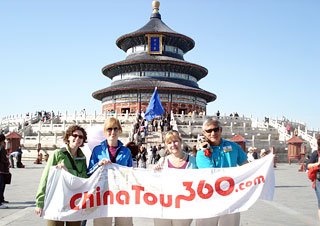 Tour at Temple of Heaven
Tour at Temple of Heaven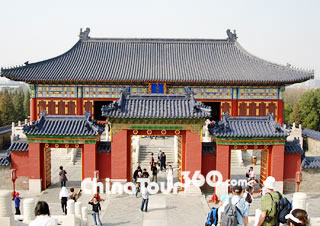 Imperial Hall of Heaven
Imperial Hall of Heaven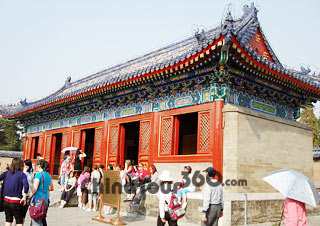 East Annex Hall
East Annex Hall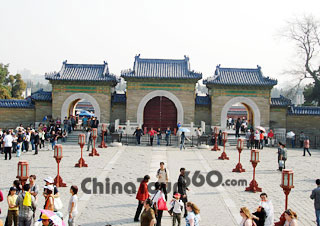 Ancient Buildings
Ancient Buildings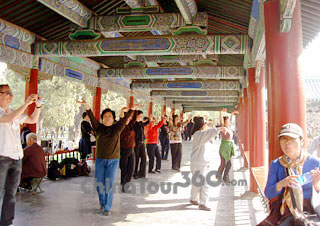 Long Gallery in Temple of Heaven
Long Gallery in Temple of Heaven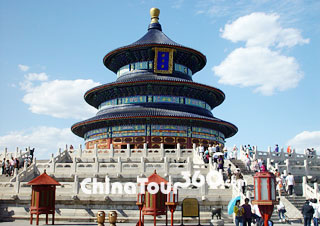 Hall of Prayer for Good Harvest
Hall of Prayer for Good Harvest
![]() Temple of Heaven Attractions
Temple of Heaven Attractions
Circular Mound Altar
Architectural Complex of Circular Mound Altar
Imperial Vault of Heaven
Hall of Prayer for Good Harvest
Architectural Complex of the Altar of Prayer for Good Harvest
Architectural Complex of Palace of Abstinence
Architectural Complex of Devine Music Administration
Attached Halls of Divine Music Administration
Originally built in 1420 during the Ming Dynasty (1368 - 1644), the Temple of Heaven is located in the southeastern part of the former outer city of Beijing, to the southeast of the Forbidden City and to the east of Zhengyangmen. This is where the emperors of the Ming and Qing dynasties held ceremonies to worship heaven and to pray for good harvests. By comparison, the other temple of heaven in Xian is much less well-known.
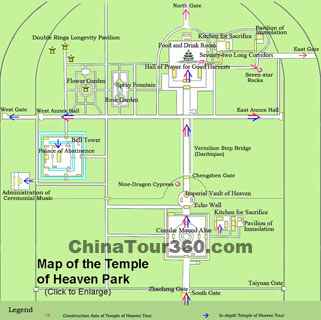 |
| Temple of Heaven Map |
The early Chinese conception of their world was that 'The heaven is round and the earth is square'. The ancient Chinese called the vast universe heaven which was said to be like a closed circle going round and round. The land upon which mankind depended for survival was called the earth. This was said to be a square platform bearing all of the creatures on it. As civilization developed, people gradually began to advocate unity between heaven and mankind. The Temple of Heaven is just one special symbol of the ancient Chinese's world outlook on the world.
According to historical records, the earliest ceremonies of heaven and earth worship can be traced back to the Xia Dynasty (21st - 17th Century BC). Ancient Chinese emperors considered themselves the sons of heaven, so they gave much respect to both heaven and earth. Every emperor , throughout the Chinese, regarded the worshipof heaven as a very important political activity. Sacrificial temples occupied a pivotal position in the construction of the capital and were always constructed using the most perfect arts, most advanced technology as well as the largest available labor force, materials and money. As the most representative work of these ancient sacrificial sites, the Temple of Heaven is both a bright pearl of the architecture of ancient China and a treasure in the history of construction.
The main buildings of the Temple of Heaven form part of the inner altar, along a straight south to north axis. All the palaces and bases are round and face south, symbolizing heaven. The groups can be divided into Circular Mound Altar, the Altar of Prayer for Good Harvests, the Palace of Abstinence and the Devine Music Administration. The four complexes performed their specific functions, constituting the core of the royal temple.
The Circular Mound Altar complex consists of the Zhaoheng Gate, the Circular Mound Altar, the South Divine Kitchen, the Imperial Vault of Heaven, the Echo Wall, the Three Echo Stones, the Dialogue Stone and the Chengzhen Gate. This is the very core of the Temple of Heaven. Besides the wonderful workmanship of the architectures, the acoustical principles blended in these buildings are also outstanding. Many buildings here relate to the number 9, as it represented the imperial power in ancient China.
Situated in the north of the Temple of Heaven, the Altar of Prayer for Good Harvests complex is the place for where the emperors prayed to heaven in early springs for good harvests. The main buildings here are the Hall of Prayer for Good Harvests, the East and West Annex Halls, the Gate of Prayer for Good Harvests, Imperial Hall of Heaven, the Long Corridor and the Butcher Pavilion. Of these, the Hall of Prayer for Good Harvests is regarded as the symbol of Beijing's ancient cultural and exhibited with many fine cultural relics.
The Palace of Abstinence, located in the southwest of the inner altar of the Altar of Prayer for Good Harvests, was where the Ming and Qing emperors would fast prior to the worship of heaven ceremony. It is mainly made up of the Beamless Hall, the Resting Hall, the Bell Tower, the Timetable Pavilion and some other buildings for living, guarding and etiquettes. Apart from the palace itself, you can also enjoy the fast exhibition. When touring around, you will probably note there is a ditch both inside and outside of the palace, which are the same as the moats in the Forbidden City. The only difference is that there is no water is in the royal ditches.
The Devine Music Administration near to the Palace of Abstinence in the southwest is where training for both ceremonial dancers and musicians was provided. The Devine Music Administration complex includes the Ningxi Hall, the Xianyou Hall, the Attached Halls of Devine Music Administration and the Gate of Devine Music Administration. At present, the Attached Halls of Devine Music Administration has been changed into the ancient royal music exhibition hall consisting of Harps Hall, Flutes Hall, Lyrics Hall, Dance Hall and Drum Hall. All of the exhibitions staged in the halls are relevant to music and musical instruments. In the Ningxi Hall, the main palace of the Devine Music Administration, there are also live music shows by professional musicians.
Being regarded as a rare treasure at home and abroad, the Temple of Heaven enjoys considerable fame for its long history and magnificent buildings the world over. The best time to visit it is in spring and autumn. It is also a good time to visit it in winter if you want to appreciate those acoustical buildings, since it is less crowded than in the peak season.
![]() Entrance Fee:
Entrance Fee:
CNY 15 (Apr. to Oct.); CNY 10 (Nov. to Mar.)
Through Ticket:
CNY 35 (Apr. to Oct.); CNY 30 (Nov. to Mar.)
![]() Opening Hours: 06:00 - 20:00
Opening Hours: 06:00 - 20:00
![]() Transporation:
Transporation:
![]() Take Bus No. 6, 34, 35, 36, 39, 41, 43, 60, 116, 610 707, 723, 743, 957 or 958 and get off at the East Gate of Temple of Heaven (Tiantan Dongmen);
Take Bus No. 6, 34, 35, 36, 39, 41, 43, 60, 116, 610 707, 723, 743, 957 or 958 and get off at the East Gate of Temple of Heaven (Tiantan Dongmen);
![]() Take Bus No. 36 (Loop Line), 53, 120, 122, 525, 610 800, 803 or 958 and get off at the South Gate of Temple of Heaven (Tiantan Nanmen);
Take Bus No. 36 (Loop Line), 53, 120, 122, 525, 610 800, 803 or 958 and get off at the South Gate of Temple of Heaven (Tiantan Nanmen);
![]() Take Bus No. 2, 7, 15, 17, 20, 69, 105, 707, 729 or 826 and get off at the West Gate of Temple of Heaven (Tiantan Ximen);
Take Bus No. 2, 7, 15, 17, 20, 69, 105, 707, 729 or 826 and get off at the West Gate of Temple of Heaven (Tiantan Ximen);
![]() Take Bus No. 6, 34, 35, 36 (Loop Line), 106, 110, 687, 707 or 743 and get off at the North Gate of Temple of Heaven (Tiantan Beimen);
Take Bus No. 6, 34, 35, 36 (Loop Line), 106, 110, 687, 707 or 743 and get off at the North Gate of Temple of Heaven (Tiantan Beimen);
![]() Take Subway Line 5 and get off at the East Gate of Temple of Heaven (Tiantan Dongmen).
Take Subway Line 5 and get off at the East Gate of Temple of Heaven (Tiantan Dongmen).








